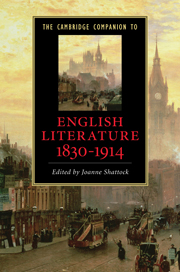Book contents
- Frontmatter
- Introduction
- Part 1 Modes of writing and their contexts
- 1 Authors and authorship
- 2 Readers and readerships
- 3 Life writing
- 4 The culture of criticism
- 5 Women’s voices and public debate
- 6 Writing the past
- 7 Radical writing
- 8 Popular culture
- Part II Intersections and incursions
- Part III The centre and the periphery
- Guide to further reading
- Index
1 - Authors and authorship
from Part 1 - Modes of writing and their contexts
Published online by Cambridge University Press: 28 November 2010
- Frontmatter
- Introduction
- Part 1 Modes of writing and their contexts
- 1 Authors and authorship
- 2 Readers and readerships
- 3 Life writing
- 4 The culture of criticism
- 5 Women’s voices and public debate
- 6 Writing the past
- 7 Radical writing
- 8 Popular culture
- Part II Intersections and incursions
- Part III The centre and the periphery
- Guide to further reading
- Index
Summary
Nineteenth-century British historians tended to analyse historical causation in terms of the agency of individuals: in this historiography, then, events were understood as having been brought about by human actions rather than by large-scale impersonal forces. In keeping with this trend, literary historians writing during the same period also tended to understand authorship in relation to personal qualities which they attributed (accurately or otherwise) to a particular writer’s character. This typically involved a delineation of what Edmund Gosse towards the end of the century termed (in his A Short History of Modern English Literature (1898)), in a comment made about Ben Jonson, 'temperament'; or, in Walter Pater’s more famous definition made in the 1880s, 'soul': literary representation, Pater explained in his essay 'Style', could best be understood as the expression of 'a specific personality, in its preferences, its volition'.
Such a view was not in keeping with contemporary European thinking, however. For example, in his widely read Histoire de la littérature anglaise (1863) the French critic and historian Hippolyte Taine elaborated a hereditary and environmental theory of authorship, defining creativity in terms of a conjunction of 'la race, le milieu, et le moment' - a proposition not dissimilar to that of Goethe’s pithy injunction, as paraphrased by the English journalist John Morley, that to 'understand an author, you must understand his age'. By contrast, even in a writer as self-consciously cosmopolitan as Matthew Arnold, who was famously critical of English parochialism, we find a residual belief in the power of the individual.
- Type
- Chapter
- Information
- Publisher: Cambridge University PressPrint publication year: 2010
- 1
- Cited by

